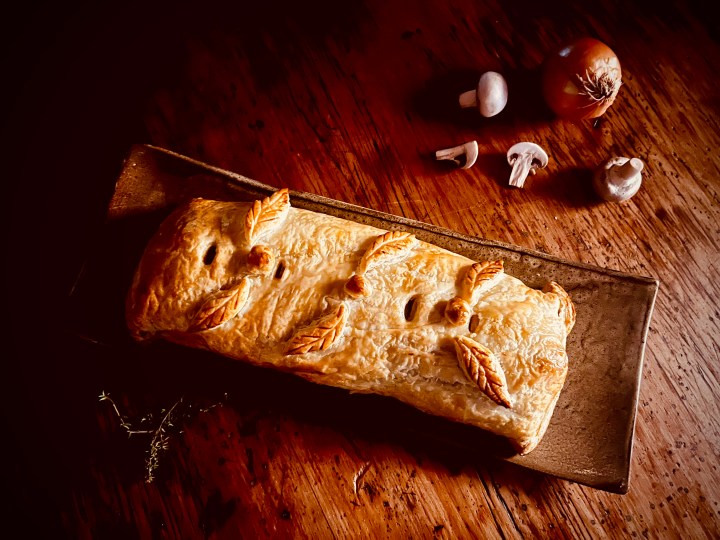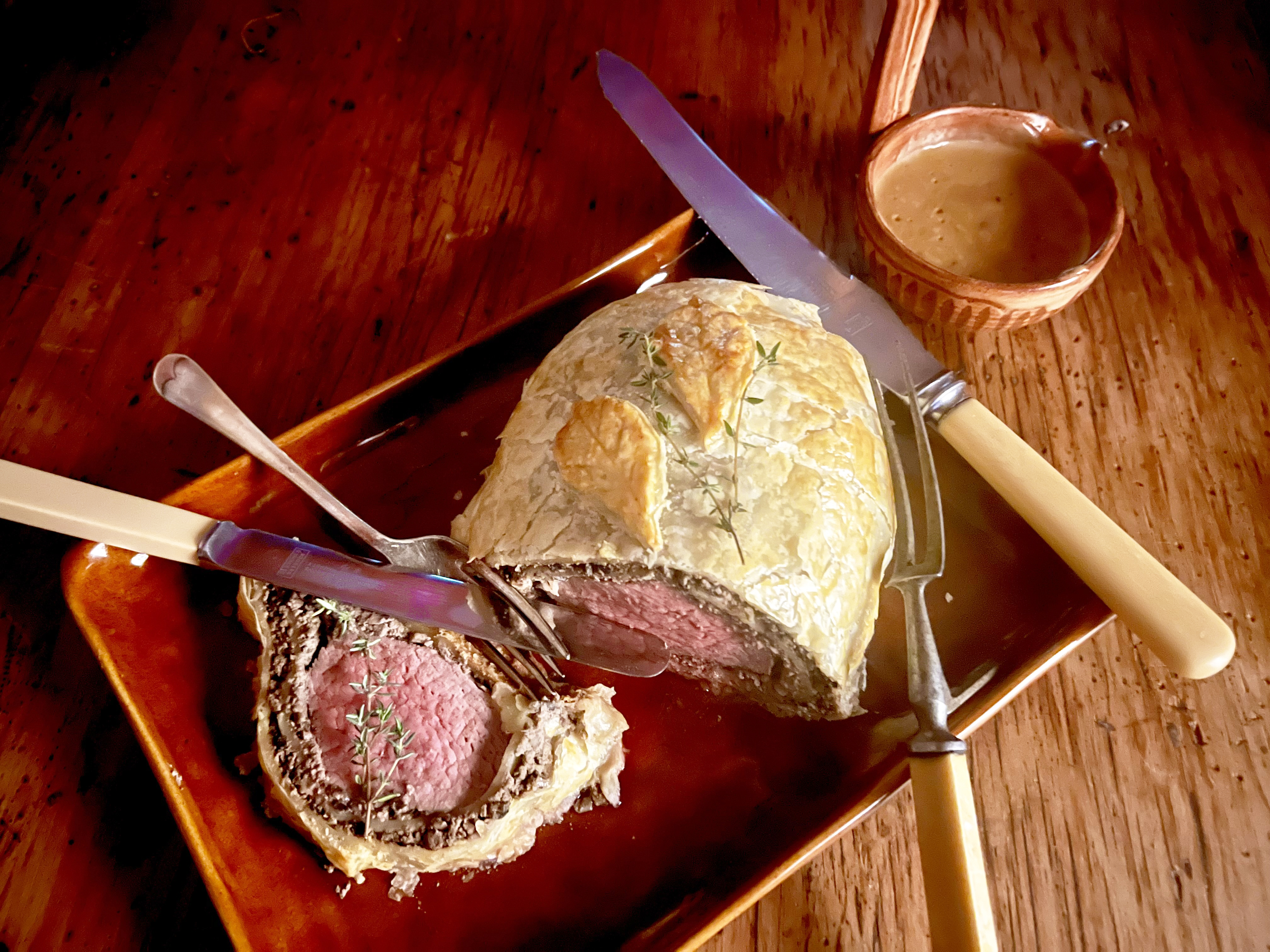A CLASSIC, REVISED
Throwback Thursday: A better Beef Wellington

Born of victory in war, a Beef Wellington is no mere pie. It stands head and shoulders above all other pies, and although it is widely believed to have been named after Arthur Wellesley, the first Duke of Wellington, as with almost every famous dish its precise origins are open to a degree of dispute and conjecture; just as the outcomes of battles are.
Many cooks have met their Waterloo in the form of a Beef Wellington. It is a stressful dish for a chef to make, demanding, precise, and unforgiving. But if you get it right, perfectly right, the investment of time and risk you have put into it will reward you with sweet and happy dreams.
I have made it before, and the astute observer may remember that Beef Wellington was the subject of my Throwback Thursday column on June 17, 2021. But I wanted to do it better.
For this newer, better Beef Wellington recipe, I made it twice. The first edition came out well, but there were finer points that I needed to hone; I was determined to do it perfectly. So I consulted a friend who is chefs’ academy trained in the art, and he came over last Saturday to teach me the finer points. The main photo is the version we made together. Here is the first one, in which you can see that the beef within is perfectly medium rare, as it is expected to be:

The earlier Beef Wellington. The crust alongside the pastry leaves is somewhat see-through however, because it was not chilled before baking; nor did I do a second egg wash. (Photo: Tony Jackman)
Beef Wellington is an exact thing. It has four elements: beef, puff pastry, duxelles, and chicken liver pâté.
You can either use a trimmed whole beef fillet, or only the tenderloin. You must, must, must use butter for browning the meat. Oil will deny you that superb buttery flavour and character that the browning of meat in butter brings.
The puff pastry can be bought (frozen) or homemade; many professional chefs are happy to use bought pastry, as these products are good and making your own is time consuming and not cost effective.
A duxelles simply consists of finely chopped mushrooms and onion or shallot, with a herb such as thyme, cooked in butter until the liquid that the mushrooms release has cooked away and you are left with a textured paste-like mixture; it is seasoned with salt and black pepper. The pâté is usually chicken liver but can be pâté de foie gras, and while it can and does contain cream, because of its purpose in a Beef Wellington you would make it with less cream than you might usually use in a pâté.
Delicious as the previous Beef Wellington was (the meat was perfectly tender and medium rare), the pastry was a tad blond in places, and the meat inside it separated from the pastry casing. These are classic problems with the dish, and I wanted to know what I had done wrong.
The pastry was blond (i.e. not puffed and crisp as it should be, and even a little see-through in parts) because of its temperature. Keeping pastry well chilled is important in pie making, I now know, thanks to my friend’s precise way with these things.
My biggest learning curve was to shape the (trimmed) fillet like a log, by wrapping it in clingfilm and then rolling it back and forth on a large, flat surface (my kitchen table) while twirling each end tight. This then goes into a very cold fridge for at least half an hour; it can even go into the freezer for a short while. This is done before searing in butter.
The balance of heat and cold is key. The oven must be red hot, so I cranked the old gas oven up to its highest point of 270℃ and gave it plenty of time to reach that temperature. Meanwhile, the prepared Wellington was in the fridge for at least 30 minutes and I added 10 to make it 40, just to be sure. The Wellington went straight from there into the hot oven, door shut.
A second point is those duxelles. It must be pasty, the liquid having completely cooked away. Mushrooms are tricky that way: they keep releasing their juices (they’re made almost entirely of water) so you need to keep going until there’s no possibility left of any more juices escaping. But before the mushrooms had gone in, I had first cooked the onions with some garlic and then added brandy for a good flambé. This adds tremendous depth and flavour to the dish; gives it a really classy edge.
Then another trick came into play. We made perfect crêpes. These are used to form a buffer between the puff pastry and the filling that sits between the pastry and the meat. It helps achieve a golden and crisp exterior, and once the Wellington is cooked and sliced you’d be hard pressed to notice that the crêpes are even there. There are alternatives to this: slices of Parma ham are often used instead of crêpes, and I have even heard of a chef using phyllo pastry to line the puff.
Another trick is to smear the seared fillet with mustard or a mixture of mustard and creamed horseradish, but not so much as to make it too wet. But I did not do that on this occasion.
Here, step by careful step, is the way we did it on Saturday…
Ingredients
1 large beef fillet, about 1 kg
4 Tbsp butter for searing
Cling film
Salt
Black pepper
1 packet puff pastry, defrosted but fridge cold (but possibly more, so have a second packet of it available if using a large fillet)
1 recipe duxelles
1 recipe brandied chicken liver pâté
3 or 4 basic crêpes
1 egg and an extra yolk for the egg wash
For the duxelles:
1 red onion
3 garlic cloves
2 thyme sprigs
250 g button mushrooms
Black pepper
Salt
For the pâté:
Please follow the link to my brandied chicken liver pâté
Method
Make sure the pastry is defrosted and in the fridge.
Earlier in the day, make some basic crêpes and have them to hand when you work with the pastry.
Make the duxelles: dice the mushrooms really small. Chop the onion similarly. Melt butter and cook the onion with the garlic and thyme, gently, until softened. Add the mushrooms, season with salt and black pepper, and cook them gently until every vestige of water they release has cooked away. Leave to cool.
Trim the fillet of extraneous bits of fat or sinew, especially the shiny strip that can be cut by using a sharp, slender knife much the way you fillet the skin of a side of fish (i.e. from the underside). Cut off the narrow bits at the ends so you have an evenly cylindrical piece of meat to work with.
Wrap the fillet in cling film (several times over) and tighten both ends while rolling it back and forth on a large, flat surface to achieve a uniform shape. Refrigerate it for 40 minutes or longer. Or pop it in the freezer for half an hour.
Try to identify a flat pan large enough for the fillet to be browned without having to twist it out of shape. Season the fillet with salt and black pepper. Melt the butter and brown it quickly on all sides. It should have a pleasing golden sear all over, but don’t go too far as it needs to be cooked medium rare.
Put it on a rack to cool, over a tray. Don’t use a plate as that would cause its juices to leach out.
Unroll the pastry (straight from the fridge) on a lightly floured surface. The thickness of bought puff pastry is fine as it is and need not be rolled out. If it’s not big enough for your fillet, add some more from a second packet, then brush it lightly with cold water and press down along the join with your fingers; the water is your glue.
Mix the pâté (or a fair quantity of it) with the duxelles. I used just over half the quantity of pâté in the recipe provided above.
Trim the crêpes and lay them out along the centre, slightly overlapping. Wet the edges with water. Spread the pâté mixture on the crêpes, edge to edge.
Unwrap the fillet and discard the cling film. Place the chilled fillet on top, centred, but near one end, leaving just enough pastry to fold neatly and seal with water at that end. Trim the other end of the pastry.
Complete the parcel, using water as “glue” as needed. Use a small, sharp knife to make 3 or 4 little incisions along the centre, to allow steam to escape while it is baking. Make 3 or 4 pairs of pastry leaves to decorate the top with. These are fixed to the top with a little water on the underside of each leaf.
Lift the prepared Wellington onto a lightly greased baking sheet. This would be a good time to turn the oven on to its highest heat (mine would be 270℃) while it chills.
Beat an egg and an extra yolk in a ramekin. Brush the top and sides of the pastry, including the leaves, with egg wash and refrigerate for it to set, about 40 minutes. Remove from the fridge and brush it with a second coating of egg wash.
Put it in the hot oven and close the door. It should bake for about 40 minutes. After 5 minutes or so, turn the heat down to 220℃. Once cooked to golden perfection, take it out and leave it on the pan, out of the oven, for 15 minutes for the meat inside to relax.
Good sides for a Beef Wellington would be creamy mashed potato, and a green such as blanched beans tossed in butter and seasoning. DM/TGIFood
Tony Jackman is Galliova Food Champion 2021. His book, foodSTUFF, is available in the DM Shop. Buy it here.
Mervyn Gers Ceramics supplies dinnerware for the styling of some TGIFood shoots. For more information, click here.
Follow Tony Jackman on Instagram @tony_jackman_cooks. Share your versions of his recipes with him on Instagram and he’ll see them and respond.
SUBSCRIBE to TGIFood here. Also visit the TGIFood platform, a repository of all of our food writing.




 Become an Insider
Become an Insider
Comments - Please login in order to comment.